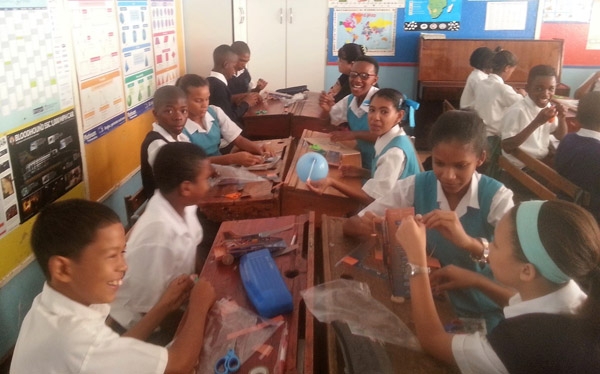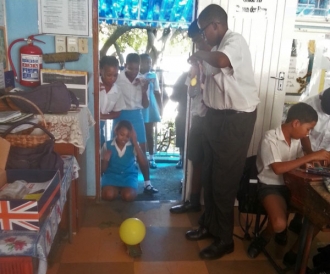
Chris Lowther, UK BLOODHOUND Ambassador, returns to Western Cape, South Africa
This is the third year that I have visited schools in South Africa in my capacity as a STEM and BLOODHOUND Ambassador during an extended holiday stay on a farm in the Paarl Area.
I visited six schools this time, three of which I had not previously visited. I went armed with two BLOODHOUND Toolbox kits provided by the Institution of Mechanical Engineers and some ‘Tomorrow’s Engineers’ posters and brochures, which proved to be very helpful. As ever, all the teachers and learners were most enthusiastic and I was made most welcome.
Why visit?
There are very few local STEM Ambassadors who visit schools to promote the virtues of engineering careers. This is something where the international engineering institutions can help by encouraging their members in South Africa (and elsewhere in the world) to become STEM Ambassadors. The worldwide shortage of professional engineers, scientists and technicians is well recognised and needs to be addressed. All existing STEM professionals and their professional bodies should take some responsibility for the future and this in one way in which they could help.
If you can spare time to inspire young people about STEM or just want to find out more about what it might involve, visit our Ambassador pages.
Drakenstein Primary School, Paarl
This was my first visit to this school, which is in East Paarl. It is a small mixed primary school, founded in 1963, in which the first language is Afrikaans and it has a lovely atmosphere!
I gave my standard BLOODHOUND interactive presentation to the 200 enthusiastic learners from grades 1 to 7, which was well received and prompted lots of questions. The presentation materials, including videos from the BLOODHOUND website, were invaluable in helping to inspire the children.
Our Lady Help of Christians Primary School, East Paarl
 This has become a regular annual visit in which I give a standard BLOODHOUND presentation to all the Grade 7 year – around 80 learners – followed by two Balloon car workshops, one for each class, aided by my wife and the teachers.
This has become a regular annual visit in which I give a standard BLOODHOUND presentation to all the Grade 7 year – around 80 learners – followed by two Balloon car workshops, one for each class, aided by my wife and the teachers.
I am always impressed by the good behaviour and concentration of the children in complete silence during the cutting out phase. Once the cars are assembled it is a different story – they are so boisterous and enthusiastic!
The headmaster, Brian Fortuin, is very keen and does a marvellous job, considering the limited resources he has available. Although it is a public school, as a faith school it only receives 60% funding from the South African Government and the school must raise the balance to pay for teachers and facilities.
Most parents pay fees for their children to attend school, even public schools, in South Africa, but the school can only charge fees which the parents can afford, so to cut costs the teachers are paid a lower rate of pay than many other state schools. The balance must be raised by other means, such as voluntary contributions and fundraising events. There is no sports or assembly hall, so the playground and the church are used for whole school assemblies, and for major school events the head must request access to the Municipality’s facilities.
Heldeberg High School, Somerset West, Cape Town
This was a return visit to update the students about the BLOODHOUND Project, and to run a Q&A session to give them an opportunity to find out more about STEM careers. The school, of over 100 learners, asked me to revisit some of the presentation I gave last year.
While the boys were most enthusiastic, the girls asked more philosophical questions about the amount of money being spent on projects such as BLOODHOUND, which prompted an interesting debate about how the world we live in is being continually improved and the quality of life for people in the developing world transformed as a result of developments in technology. Some of this is as a result of cutting-edge technology projects, which often have surprising spin-off benefits. The Tomorrow’s Engineers posters, including ‘Save the world as an Engineer’, were very helpful in putting this point across.
The school has a wonderful cooperative atmosphere and I have already been invited to return next year.
“Thank you so very much for coming to Helderberg High School and answering the many questions we had about the project. As someone who intends to study in the STEM field one day, I thoroughly enjoyed the entire presentation and the Q&A session, and it has inspired me to look into things like computational fluid dynamics that I hadn't know about before.”
“Teenagers in today’s society are often connected [via social media] to things that astound us. However, BLOODHOUND trumps anything I’ve ever seen!”
“Your presentation… inspired me to learn more about technology and consider it as a possible career, and I assume it did the same for many others. Projects like this inspire us as students to take interest in Maths and Science. You are literally changing lives.”
“This project is beyond interesting, as it captures many different fields of interest into one project. I believe you are doing a great thing and I appreciate all the good you are doing for South Africans and my brothers overseas. This is clearly a big step towards employment, industrialisation and positive change.”
Parel Vallei High School, Somerset West, Cape Town
This was a chance to revisit this school to conduct a Q&A session for the older learners. It was a voluntary session and I was slightly disappointed that there were only three girls out of around 20, but at least they were enthusiastic. There is still much to be done to persuade girls that a career in technology and engineering is for them too.
It was a lively session, with many interesting questions being posed, which engendered much debate. The Head of Science, Mrs Manthey, is a great enthusiast for STEM as a result of her father being a nuclear engineer and is constantly encouraging more children, especially girls, to consider a STEM-related career. I’ll be back in 2018 to help!
Westerford High School, Newlands, Cape Town
Westerford High is a mixed high school in Newlands, near the University of Cape Town, where I addressed about 150 learners from grades 8, 9 and 10. The presentation went well and I have promised to visit again next year to speak to the senior matriculation (sixth form equivalent) learners.
One thing I did notice, though, was the IT Tech Team. As at most schools, the team was made up of keen senior learners, who always manage to successfully adapt my PowerPoint presentation and videos to their own school audiovisual system. This is great practical experience for them, but without exception, they comprise boys and no girls. Why is this?
Paarl Boys High Senior School, Paarl
Three generations of boys from the Durr family, on whose farm we stay, have attended or attend Paarl Boys High School, where I presented to the whole senior school of around 800 boys. It is a public (state) school with good facilities and an excellent reputation.
When asking whether anyone knew how a jet engine worked, for the very first time in all my visits to schools in UK and South Africa, I received a comprehensive and accurate answer from one of the senior boys. I asked him to explain each phase of the process and then to conduct volunteers who formed the human jet engine in a role play enactment, which he did to much applause from the boys.
Afterwards I asked him whether he had learned about jet engines during science classes and predictably the answer was no. He had conducted research in his own time out of interest. I believe science curricula should include more information about ‘How things work’ to provide practical examples of the application of scientific theories.


